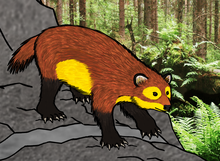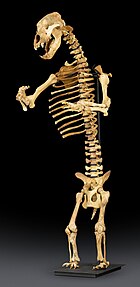安盧熊屬
| 安盧熊屬 化石時期:
| |
|---|---|

| |
| 復原圖 | |
| 科學分類 | |
| 界: | 動物界 Animalia |
| 門: | 脊索動物門 Chordata |
| 綱: | 哺乳綱 Mammalia |
| 目: | 食肉目 Carnivora |
| 科: | 熊科 Ursidae |
| 屬: | †安盧熊屬 Ballusia Ginsburg & Morales, 1998 |
| 模式種 | |
| †Ballusia elmensis | |
| Species | |
| |
安盧熊屬(學名:Ballusia)是一個滅絕的小熊屬,生存在早中新世,大約2005萬至1800萬年前。被歸入該屬的化石遺骸在歐洲(波蘭)和亞洲(俄羅斯、蒙古、中國)都有發現[1][2]。安盧熊屬是在1998年建立的,最初是基於被歸為祖熊屬和半熊屬不同物種的化石,其中B. elmensis是模式種[3]。
安盧熊屬與「真正」的熊(包括現代的熊亞科)的確切關係尚未完全理解:許多古生物學家將其歸類為熊亞科的原始成員,但其已知的骨骼元素與滅絕的半狗亞科有一些共同特徵。因此,一些研究者將Ballusia稱為Ursidae incertae sedis[3]。Ginsburg和Morales認為B. elmenensis是祖熊屬的祖先,Marciszak和Lipecki也是這樣認為的,儘管兩個屬的時間範圍似乎有重疊[4] [5]。
描述[編輯]
安盧熊屬比大多數現代熊物種都要小:該屬物種B. orientalis[6]的化石遺骸表明這種動物的大小與家貓相似,身體比例類似於狼獾,而B. elmenensis的大小則與歐亞山貓相似[4]。安盧熊屬具有纖細的腿部[7],相對於現代熊物種來說,它的尾巴也更長。
參見[編輯]
參考資料[編輯]
- ^ Baryshnikov G.F. & Lavrov A.V. (2015). "Early Miocene bear Ballusia (Carnivora, Ursidae) from the locality Khirgis-Nur-I in Mongolia". Proceedings of the Zoological Institute RAS 319(3): p. 341–350
- ^ Sotnikova M, Klementiev A, Sizov A & Tesakov A (2021). "New species of Ballusia Ginsburg and Morales, 1998 (Ursidae, Carnivora) from Miocene of Eastern Siberia, Russia". Historical Biology 33(4): p. 486-497. doi.org/10.1080/08912963.2019.1637864
- ^ 3.0 3.1 Ginsburg L & Morales G (1998). "Hemicyoninae (Ursidae, Carnivora, Mammalia) and the related taxa from Early and Middle Miocene of Western Europe". Annales de Paléontologie 84(1): p. 71-123. doi.org/10.1016/S0753-3969(98)80003-7
- ^ 4.0 4.1 Marciszak A & Lipecki P (2020). "The history of bears (Ursidae, Carnivora, Mammalia) from Silesia (southern Poland) and the neighbouring areas". Geological Quarterly 64(4): p. 876–897 (頁面存檔備份,存於網際網路檔案館)
- ^ Qui Z-X, Deng T & Wang B-Y. (2014). "A Late Miocene Ursavus skull from Guanghe, Gansu, China". Vertebrata PalAsiatica 52(3): p. 265-302 (頁面存檔備份,存於網際網路檔案館)
- ^ Qui >, Yan D, Hang J & Wang B (1985). "Dentition of the Ursavus skeleton from Shanwang, Shandong Province". Vertebrata PalAsiatica 23: p. 264-275
- ^ Jiangzuo Q & Flynn J.H. (2020). "The Earliest Ursine Bear Demonstrates the Origin of Plant-Dominated Omnivory in Carnivora". IScience 23(6): doi.org/10.1016/j.isci.2020.101235 (頁面存檔備份,存於網際網路檔案館)
| ||||||||||||||||||||||||||||||||||||||||||||||||||||||||||||||||||||||||||||||||||||||||||||||||||||

